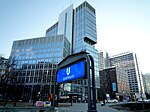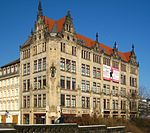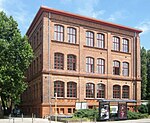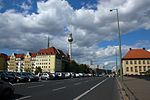Luisenstädtische Kirche
1695 establishments in the Holy Roman Empire18th-century Lutheran churches in GermanyBuildings and structures demolished in 1945Buildings and structures in Berlin destroyed during World War IIBuildings and structures in Mitte ... and 4 more
Churches completed in 1695Former churches in BerlinLutheran churches in BerlinRuins of churches destroyed during World War II

The Luisenstädtische Kirche was a church building in Berlin, in the former Luisenstadt district (now part of the Berlin-Mitte and Friedrichshain-Kreuzberg districts), on Alte Jacobstraße between Sebastianstraße and Stallschreiberstraße. It was originally known as the Kirche in der Cöpenicker Vorstadt (church in the Köpenick suburb), then from 1785 to 1795 as the Köllnische Vorstadtkirche (Cöllnian suburb church), then from 1795 to 1837 as the Sebastiankirche, after presbyter and city-councillor Sebastian Nethe, taking its final name in 1837.
Excerpt from the Wikipedia article Luisenstädtische Kirche (License: CC BY-SA 3.0, Authors, Images).Luisenstädtische Kirche
Alte Jakobstraße, Berlin Mitte
Geographical coordinates (GPS) Address Nearby Places Show on map
Geographical coordinates (GPS)
| Latitude | Longitude |
|---|---|
| N 52.509 ° | E 13.4073 ° |
Address
Gedenkstele Luisenstädtische Kirche
Alte Jakobstraße
10179 Berlin, Mitte
Germany
Open on Google Maps









